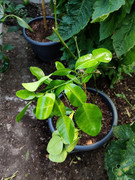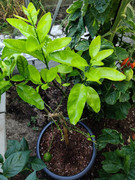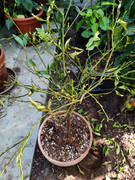Hi,
For 2 years now I am tirelessly trying to keep citrus trees alive, but so far I managed to kill 8 already

I buy grafted trees which are probably no older than 2 years from a local vendor who sells exotic plants, he gets them from growers in sicily, Italy.
I bought Kaffir limes, Key limes, persian limes and limequats and from other sellers I bought cuttings of kaffir lime and persian lime.
The internet is full of different kinds of information which is very contradictional and caused much grief.
First trial was with a kaffir lime put in purchased potting mix for citrus plants, the plant was grafted and eventually died from rootrot and armoured scale.
Because people said this kind of soil was not good I found a Dutch site describing to use 50% white sand and 50% compost, but that soil instantly killed the next 2 plants because that soil did not drain at all and remained very wet for weeks.
Third trial was with another Kaffir lime and Key lime using a potting mix of equal parts of perlite, vermiculite and coco peat or peat moss (but I prefer coco peat), that soil appeared to be needed in very hot climates such as South california but definitely not in central Europe, soil stayed too wet because the vermiculite retained moisture too well, but it did drain much better.
However, plants died after a few weeks.
Note that in the second and third trial I washed the old soil off the roots with water, probably this also stressed the plants too much.
Last test I re-used the soil from the vendor's pots and added a bit fresh potting mix and compost, so basically the composition was: equal parts of potting mix (universal), regular soil with sandy structure and I added perlite to improve aeration.
This time I did not wash the old soil on the roots and just loosened the roots on the edge of the root crown, left the soil on the rest so stress would be minimal.
I put it in a pot that was 10cm bigger (wider and higher) than the previous one.
After one week the kaffir lime and persian lime dropped all leafs, some branches turned brown, even though I reduced my watering regime.
I let them dry out (not fatally) and give it little bits of water once a week, then they start to grow new foliage, but more branches die off.
Weeks later the new foliage is nice and big, suddenly the plant stops growing, new buds wither and turn brown, some tiny green leafs fall off.
In the meantime I also got a limequat, repotted it the same way, it was fine for 3 weeks, then suddenly one day when I was supposed to water it, 90% of its leafs were dried out and fell off. Some healthy ones too for unknown reason.
The food I give them is Floranid Twin Permanent with NPK of 16-7-15, which turns out to be the best slow release fertiliser compared to all other liquid ones I tried.
There were no aphids/scale present on any of the plants.
To this end I am slowly to the point of breaking down and giving up on these grafted horrors. I know growing from seeds is not done in commercial areas because of viruses passing on but germinating lime seeds is more successful than keeping those trees alive...
But regardless I wanted to find out if there's anything different I can do.
As for the location: 2 years ago I put them outside, that tree could withstand bright sunlight, until I repotted it. After many attempts to get the information out of the vendor, I now put it in my greenhouse (where it's warmer) where there is a shade cloth to protect the limes from burning sun. The roof of the greenhouse has partially filtered glass so no bright sunlight can get in. The vendor told me he put them in there too with similar conditions, even when it was very hot.
So it is sheltered from wind there and gets filtered sunlight, protected from the western sun.
Attached are pictures from a kaffir lime, persian lime and limequat as they are right now.

-> Kaffir lime

-> Persian lime

-> limequat